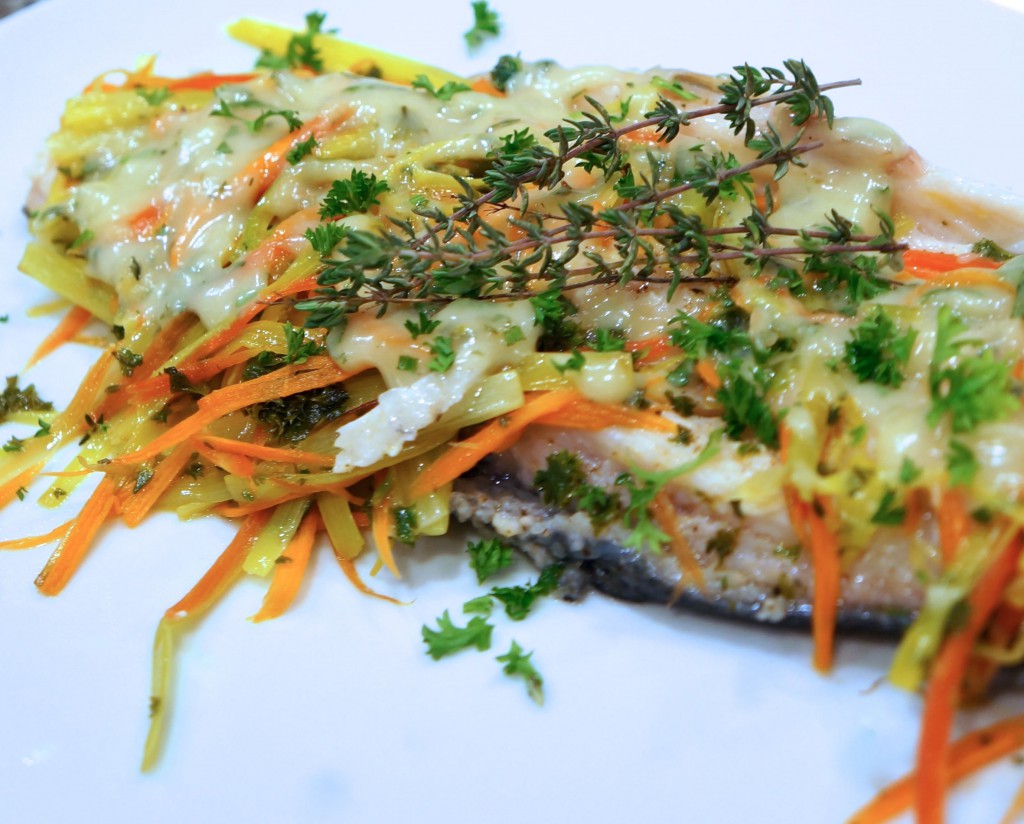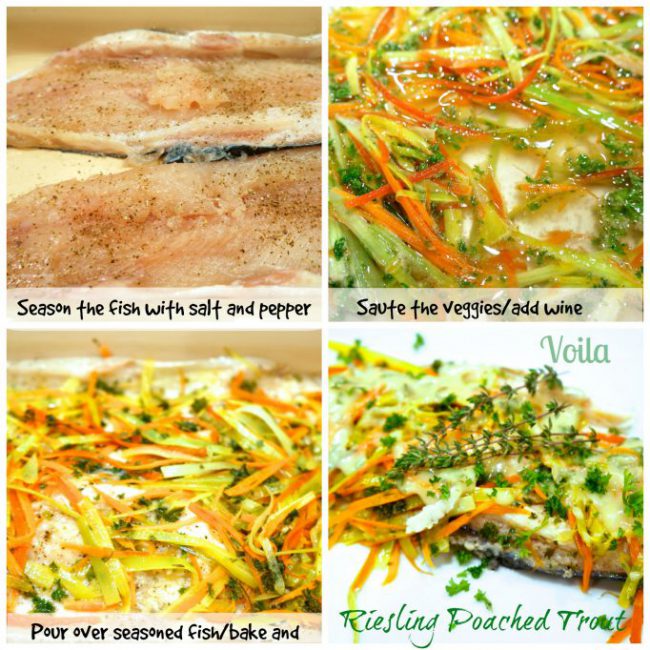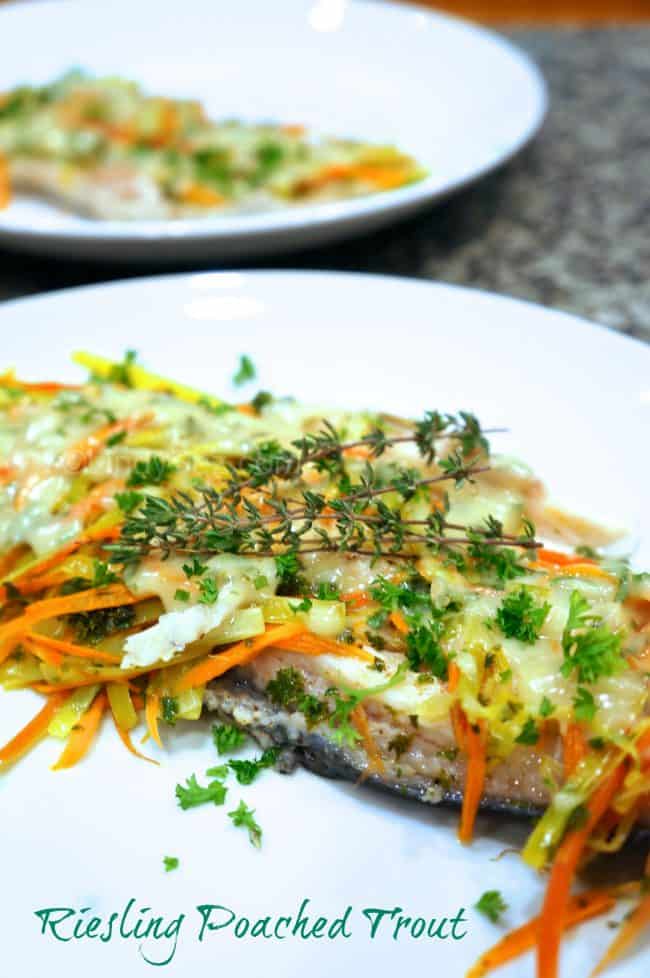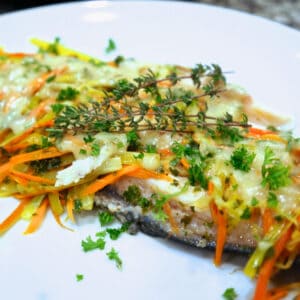Use a flavorful, but not sweet, Riesling wine to make this simple healthy recipe for Riesling Poached Trout. It's a quick, easy, weeknight meal but impressive enough for company.

How to make easy Riesling Poached Trout
Trout is a very versatile fish.
You can bake it, poach it, fry it, grill it.
This recipe for Riesling Poached Trout with Vegetables is going to use, as the name indicates, the poaching method. Poaching is going to keep the calories down while allowing the wonderful flavors of the fish, wine, and vegetables to shine.
"This is a really easy, tasty way, to serve trout"
Let's talk a minute about Riesling wine
When I travel with my husband and we are pouring Riesling as a part of our wine tasting, I can't tell you how often people come up, faces skewed, fingers making the sign of an X, mouths working before they even get up to the tasting table "No thanks, I'll pass on the Riesling".
"Why" is the question I always ask. And I know what the answer will be.
"I don't like sweet wine".
"But, wait, this wine is not sweet. Please, just give it a try". And, after all, is said and done, isn't that what wine tasting is all about? Tasting different wines?
Once they taste, a lightbulb goes off,
- WOW, this is not sweet at all.
While a late harvest Riesling is very sweet, a properly made Riesling should not be. A true Riesling is...
- One of the more floral wines and when well made should offer good acidity, along with notes of diesel.
- A well-made Riesling can lay down in your wine cellar (if you have one) for 15 to 30 years, depending on the maker.
- How can you tell if the Riesling you are about to buy is good or not? Well, partly by price, but more by from where it was grown and made.
- Rieslings made in Alsace are a good choice, (although not always); as well as some of the newer ones coming from Australia and South Africa, although these are heavier in lime flavors.
- There are also some great California Rieslings. Just ask your wine monger to point you to one that is not full of pear and sweet sugars, tell them you want a Riesling done in the style of Alsace. They should be able to send you to a proper wine.
Trout, freshly caught or store-bought
Trout is easily found in most grocery stores; and if you can find it already filleted all the better.
But if you have to buy your fish whole and bone it yourself, no worries. It's pretty easy to do.
If you are lucky enough to be able to go fish for your own fresh fish, all the better. Here's a little primer on learning How to Fish.
Step by Step instructions

Faux cream sauce keeps it light
To keep this dish as low in fat and calories as possible, I've used my favorite method of making a cream sauce, yes, it's mixing 2% milk with cornstarch - the rich mouthfeel keeps the tastebuds happy, and the 2% milk keeps the waistline happy. Happy happy, that's the way I like it.
This recipe is highly modified from a 2001 Epicurious.com recipe but since that was my inspiration, I'll give them their due.

Want some more easy company-worthy fish dishes? Try one of these...
CRISPY SKIN SALMON WITH LENTILS AND BACON
SNAPPER WITH CARROT-CURRY SAUCE OVER COUSCOUS
TURMERIC MARINATED FISH WITH RICE NOODLES AND HERBS
HALIBUT AND FORBIDDEN RICE IN A SAFFRON CREAM JUS
SESAME CRUSTED YELLOWTAIL TUNA WITH TWO SAUCES

Easy Riesling Poached Trout
Ingredients
- 4 6 to 8 ounce trout filets, boned with skin
- 2 teaspoons extra virgin olive oil
- 2 teaspoons unsalted butter
- 1 large leek white and light green part only, cleaned well
- 1 large carrot peeled
- 2 tablespoons fresh minced parsley
- 1 teaspoon fresh thyme leaves or ½ teaspoon dried
- 1 ½ cups dry Riesling wine
- ¼ cup 2% milk or cream or half and half
- 2 teaspoons cornstarch
- 2 teaspoons fresh or dried tarragon
- Salt and freshly ground pepper to taste
Instructions
- Using tweezers or needle-nose pliers, remove all the pin bones from the trout. Season the flesh side with salt and pepper.Set into a 13 x 9-inch baking dish. Heat oven to 375°F.
- Cut the leek and carrot into 2 ½ to 3-inch pieces, cut each piece in half, and then into a fine julienne.
- Heat the butter and oil together in a large skillet, when the foam from the butter subsides, add the julienned vegetables; saute until crisp-tender, about 5 minutes. Stir in the parsley, thyme leaves and wine, season with salt and pepper. Bring to a simmer; pour over the fish.
- Place the fish in the oven and cook for about 5 - 7 minutes. (At this point, the fish does not have to be cooked through.) Remove the fish and vegetables from the poaching liquid and place on a serving platter, cover with foil, and return to the oven.
- Pour the wine into a saucepan and reduce by ½. Combine the milk and cornstarch together in a small bowl; add mixture to the saucepan along with the tarragon. Stir until thickened. Taste and adjust seasonings.
- To serve: Place one filet of fish onto each warmed plate; spoon sauce over. Sprinkle additional parsley over, if desired.

Leave a Reply